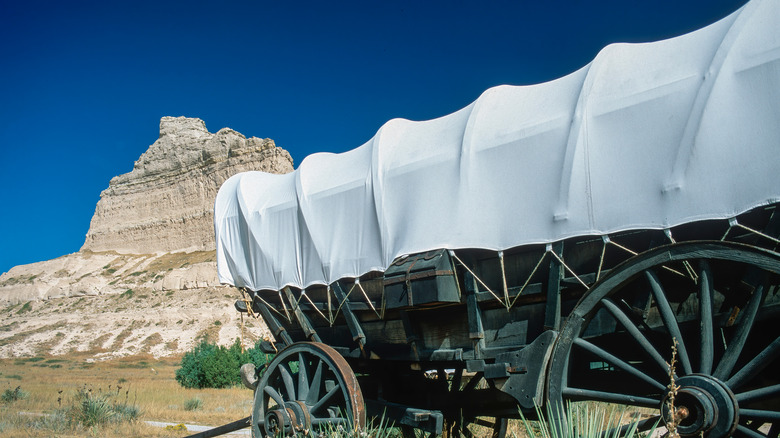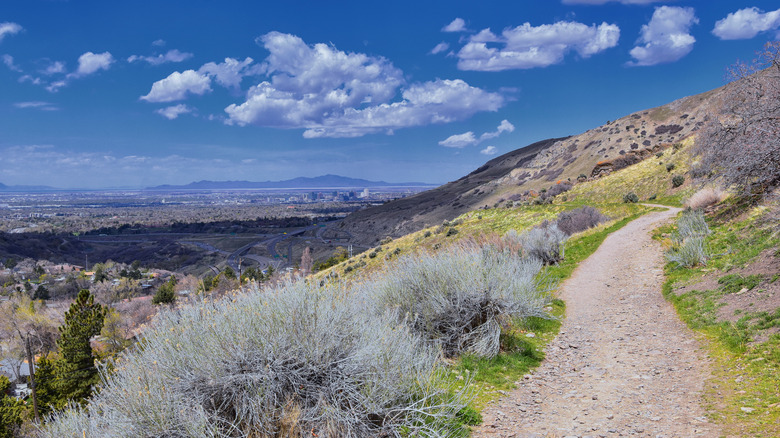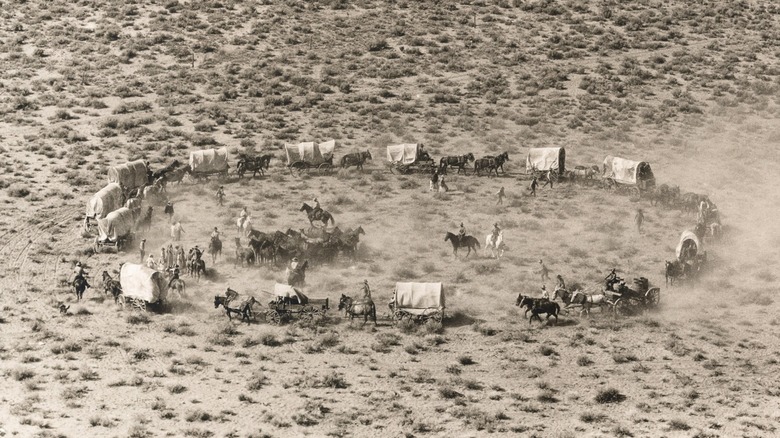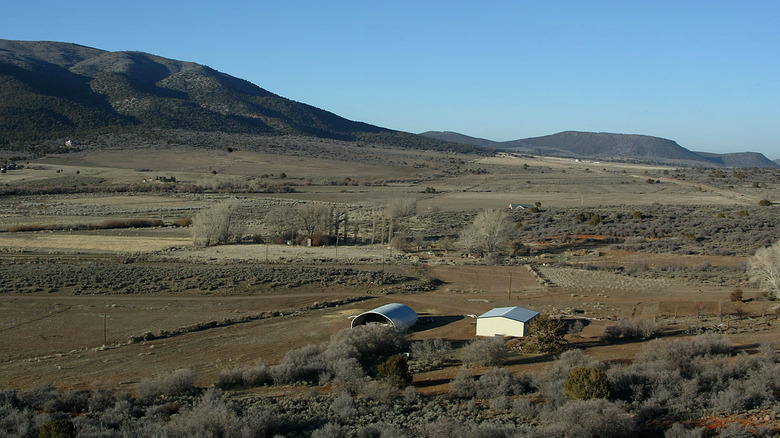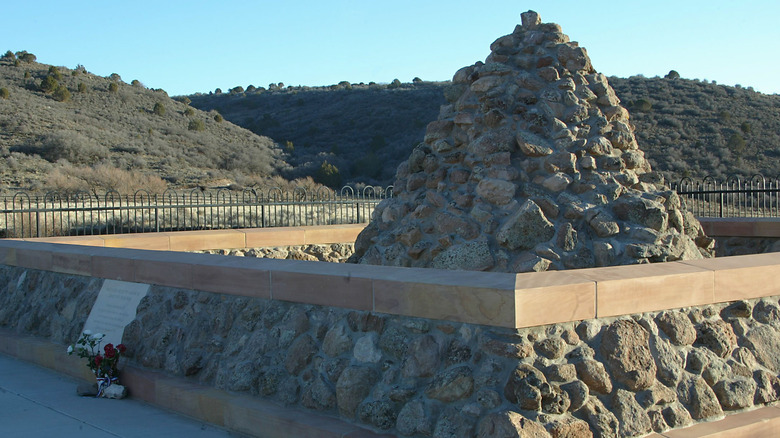The Mountain Meadows Massacre Explained
As NPR reports, many historians consider one horrific incident in 1857 the "worst event in Latter-day Saint history," as well as the history of the United States. Men, women, and children were left defenseless and caught off-guard during a violent attack in Utah. What really triggered the Mountain Meadows massacre, and what actually happened that day?
In early 1857, a group of about 150 people and about 900 cattle began a lengthy journey across America (via Utah Education Network). In 40 wagons, the group of emigrants started in Arkansas that April. They were planning to end their journey in California, but since the trip was so long, they knew they would need to stop at settlements along the way to re-supply.
Meanwhile, in Utah, there was an intense fear being instilled in the Latter-day Saints community, Smithsonian Magazine reports. An event in April 1857 was probably the spark that lit the powder keg. A polygamous church member from Arkansas, Parley P. Pratt, was murdered by the husband of one of his wives. When news of the murder traveled to Utah, Latter-day Saints there were stunned and scared — they believed that Pratt had been killed for religious reasons by Americans, a group the church viewed as threatening outsiders. Religious leaders warned the community that American soldiers were coming to get them in order to put a stop to their polygamous lifestyle, and an intense panic set in for the Utah Latter-day Saints community (per NPR).
Utah Mormons prepared for invaders
The Utah Education Network reports that the Utah Latter-day Saints were becoming poised for war, and in fact, on August 5, the governor declared martial law. Suddenly, anyone who was traveling through Utah would need permission — which the already-traveling Arkansas emigrants would have no idea about. A church militia formed, ready to attack if necessary. Completely unaware of the heightened tensions, the Arkansas wagon train arrived around August 10 in Salt Lake City, Utah.
Utah residents were told not to sell goods to travelers who did not have a travel pass, and instead to save it all for themselves in case war broke out. That was a major inconvenience for the Arkansas emigrants, who were traveling by wagon and getting low on supplies for both the humans and their livestock. The situation caused frustrations between the groups to grow even more.
Per Smithsonian Magazine, it is highly likely that Brigham Young, the Latter-day Saints church president at that time, was involved in the planning of defensive maneuvers. For example, he reportedly tried to get a nearby tribe of indigenous people, the Paiutes, to join the Latter-day Saints in forming a defense against those he saw as invaders.
Emigrants become trapped in place
Other church leaders like John D. Lee and George A. Smith told the Paiute tribe that the approaching Americans were going to try to poison their water supply or livestock (via Smithsonian Magazine). Utah Education Network reports that around September 7, Paiutes joined with the Utah Latter-day Saints to start attacking the Arkansas emigrants. On the first day, seven people were killed, and 16 were injured. It was the start of a bloody four or five days.
Over the following days, a siege took place, according to Smithsonian Magazine. They shot at each other, and the Arkansas wagon train members arranged their wagons in a circle for protection, and dug trenches. Per NPR, with nowhere to escape to and pinned in place, the emigrants were at a great disadvantage. They were very low on food, water, and ammunition, since the Utahans had been instructed not to give them anything. Around September 11, 1857, the fight came to a horrific conclusion.
A bloodbath at Mountain Meadows
Smithsonian Magazine reports that William H. Dame, a Utah leader, instructed the militia group to kill everyone, even children, and leave behind only those children who were so young that they wouldn't understand what had happened. Waving a white flag, John D. Lee and a group of other Utah Mormons went forward and interrogated the emigrants.
Per Britannica, the Arkansas group insisted that they were just moving between states, and weren't there to cause any trouble. Regardless, Lee demanded that the group leave all their possessions, including weapons, behind, and the group acquiesced. Even when Lee told them to leave their livestock behind, the emigrants didn't have much of a choice (via Smithsonian Magazine).
Things then took a nasty turn (via Britannica). The now-defenseless group of men, women, and children thought they were going to continue their journey. But suddenly, Lee and the other Latter-day Saints ambushed them. It was a tragic bloodbath.
Only babies escaped Mountain Meadows
The unarmed men in the Arkansas group agreed to walk side by side with the fully-armed Utah group (per NPR). One of the Utah leaders suddenly shouted for his men to stop. Then, the Utah men immediately turned and shot every single man from the wagon train, killing them instantly. The group then targeted the women and children, who were killed with clubs or stabbed with knives. Reportedly, the travelers begged the Utah group to spare them, but according to The Los Angeles Star, at least 25 families were killed. Not a single emigrant over the age of 7 made it out of the Mountain Meadows alive, and only 17 babies escaped (per Smithsonian Magazine).
Those 17 infants were then raised by the same Latter-day Saints families who had killed their biological parents and siblings (via Utah Education Network). It's believed by some that the remains of the dozens of slaughtered people were left to be consumed by animals, or were thrown into nearby ravines in order to cover up the massacre, although Smithsonian reports that the victims were buried "hastily."
The Morning Chronicle reported at that time that the emigrants had tried to poison the indigenous people. For quite a long time, Paiutes were blamed for the attack, but the most recent research has revealed that some of the Utah militia group were actually disguised as Paiutes (via NPR). The actual tribe was not as involved as the Latter-day Saints tried to claim. The most likely reason for the massacre was that the Utah Latter-day Saints listened to their leaders during what they believed was a time of war.
A letter could have stopped the attack
In a tragic twist, Utah Education Network reports that two days after the massacre, the Utah Latter-day Saints received a hastily-written message from their leader, Brigham Young. In the letter, he had urged the group not to attack the Arkansas wagon train. But it was two days too late to stop the carnage at Mountain Meadows. Plus, per Smithsonian Magazine, in 1858, the American military did show up to talk with the Utah residents, and no bloody war broke out as they had anticipated. Instead, the leaders talked things out without violence.
NPR reports that the Mountain Meadows massacre was so bloody that Latter-day Saints leaders tried to destroy all the evidence, blame the Arkansas group, and scapegoat the Paiutes. It wasn't until 2008 that church historians were able to reveal the whole story.
However, John D. Lee was punished for his role in the mass murder in 1877, when he was executed near a monument dedicated to the Arkansas wagon train group, according to The Cincinnati Daily Star. Reportedly, just before he died, Lee claimed that he was being sacrificed by Latter-day Saints leaders, who had turned their backs on him. Per LDS Living, the Church of Jesus Christ of Latter-day Saints officially recognized its role in the attack 150 years after, in 2007, saying, "What was done here long ago by members of our Church represents a terrible and inexcusable departure from Christian teaching and conduct."
